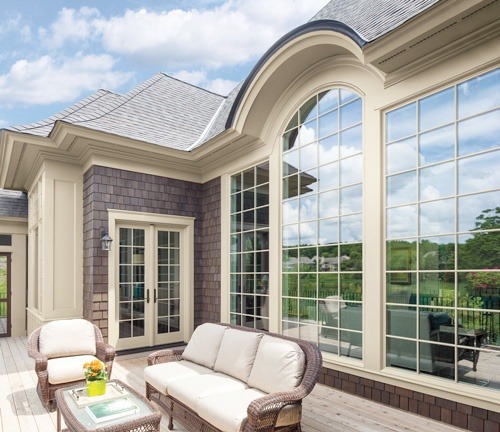


When a window is marketed as “energy efficient,” what does that really mean? What qualities of that window make it capable of reducing your home’s energy usage? There are several aspects of energy-efficient design that contribute to their energy-saving abilities. Here’s a closer look.
Glass Panes
Years ago, most windows consisted of one pane of glass only. Glass is excellent at transferring heat, so a single pane of standard glass lets a lot of heat seep into your home during the summer. Today’s energy-efficient windows are made with two or three panes of glass rather than one. The gas trapped between the glass panes acts as an insulator, slowing the transfer of heat. As a result, your air conditioning bills are lower since your AC unit is not having to compensate for as much warmth seeping into your home.
For maximum insulation, some energy-efficient windows have not air but argon gas between the two or three panes. Argon is an even better insulator than air; it reduces heat transfer even further.
Glass Coatings
Many energy-efficient windows also have a coating on the glass that causes the glass to reflect more heat rather than absorb it. Known as low-e coatings (the “e” stands for emissivity, a measure of how much heat is absorbed by a material), these glass coverings are great in areas like Michigan where the summer temperatures are high, and the sunshine is bright. Andersen‘s SmartSun™ glass does not just reduce heat transfer; it also blocks harmful UV rays to protect your family and your decor from the harmful effects of sunlight. You can enjoy basking in the sun without worrying about your skin’s health.
Sash Material
The material surrounding the glass also plays a large role in determining a window’s efficiency. If the material warps and pulls away from the glass as it ages, then warm air can blow in through the gaps, increasing your air conditioning costs. If the material itself is not a good insulator and instead transfers a lot of heat, your energy bills will also go up.
Many homeowners like the traditional look of wooden window sashes, but since wood can warp and sag as it ages, it is not the most energy-efficient choice. Wood composite products, like Fibrex®, make for more energy-efficient windows since this material stays stable and rigid in spite of temperature changes. Since it is made with a mixture of plastic polymers and wood fibers, Fibrex also resists rot and decay, so it won’t lose its efficiency and start leaking after a few years like traditional wood often does. It’s an excellent insulator and blocks heat transfer, too.
Installation
Even the most energy-efficient windows won’t lower your energy bills if they are not installed properly. Every window is different and must be carefully placed and sealed to prevent air leakage and ensure balanced operation. A window installed out of balance may be difficult to shut completely or may settle improperly, leading to leaks and decreased efficiency. Window installation is not a DIY job or one that should be taken lightly. When you purchase new windows for your home, it is always important to have them installed by experienced professionals. Work with a company that offers a warranty on their installation services so that if a mistake is made during installation, you are covered.
When you’re ready to replace the windows in your Michigan home, contact Renewal by Andersen. We offer free in-home consultations, industry-leading warranties, and some of the most energy-efficient products on the market.